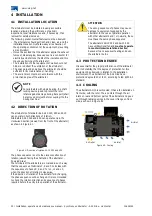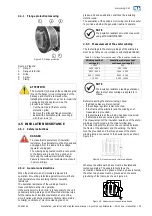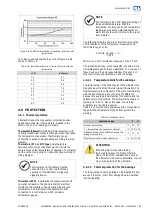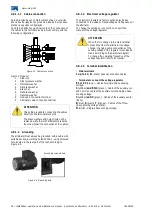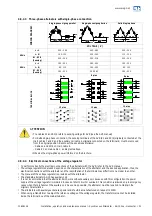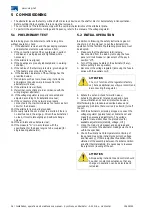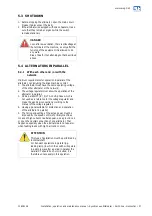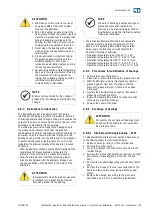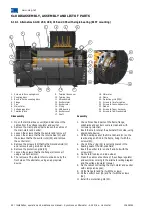
12638144 Installation, operation and maintenance manual – Synchronous Alternator – AG10 line - Horizontal l 27
4.6.5
Protection of the voltage regulator
4.6.5.1
Protection against underfrequency
To put the alternator into operation, the underfrequency
protection of the voltage regulator should be set at 90%
the nominal frequency (already set at the factory) or stay
with the voltage regulator off until the group reaches the
rated speed, avoiding overcurrent in the auxiliary coil
windings and excitation of the alternator.
NOTE
The other protections of the voltage regulator
are described in the manual specific to it.
Application 60 HZ
Application 50 HZ
4.7
VOLTAGE REGULATOR
The electronic voltage regulator is designed to keep the
voltage of the alternator constant independently of load.
It may be mounted in the AVR connection box or on the
control panel.
ATTENTION
Check in the
Manual of the voltage
regulator
the terminals and wiring diagram
and trimpots for adjustment.
A wrong connection can mean the burning of
the regulator and / or the alternator windings.
Defects caused by this reason are not
covered under warranty.
For further technical details of the operation, functions,
connections, settings and anomalies, etc., refer to the
specific manual of the voltage regulator.
4.7.1
Maintenance of the short-circuit current
WEG alternators AG10 line, are manufactured with the
auxiliary winding placed in slots of the main stator isolated
from the main winding. This coil has the function of
feeding the power circuit of the voltage regulator and to
maintain the short-circuit current of the alternator.
NOTE
1.
Due to the fact of the alternator to keep
high Icc, an overcurrent relay must be
provided and to open the main breaker in
no more than 20s, under risk of burning
the alternator.
2.
To maintain the short circuit current above
3.0 x In, refer to WEG.
4.8
ELECTRICAL FEATURES
4.8.1
Electrical connections
The electrical connections of the alternator are
responsibility of the end user and should be done by
trained people. The connection diagrams can be found in
item 4.8.2.
4.8.1.1
Main connection
The main cable connections must be made in accordance
with the diagrams in this manual, using tightening torque
according to Table 4.9 for fixing cables.
Table 4.9: Tightening torque of terminal screws for fixing the main
cables
Screw diameter
Tightening torque
(Nm)
M5
4 - 5
M6
8 - 9
M8
19 -21
M10
38 - 42
M12
67 - 73
M16
143 - 157
NOTE
The tightening torques of electrical terminal
connections are informed in the alternators
terminal boards.
Make sure the section and insulation of the connecting
cables are suitable for the current and voltage of the
alternator;
Before making electrical connections between the
alternator and the load or power network, it is required
to do a careful check of the insulation resistance of the
winding, as shown in item 4.5.
(V)
Un
U/f
45
(Hz)
50










